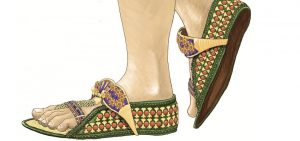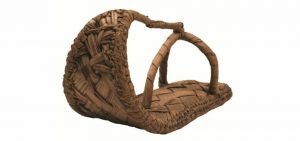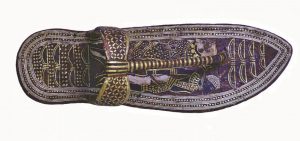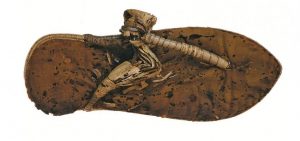
It’s summer and flip-flops are in full bloom! Over the centuries, shoe designers have added heels, blinged them out, and crafted them from a variety of materials. The obsession for this ancient sandal has even sprouted its own national day (#nationalflipflopday). Today, the flip-flop industry generates billions in revenue sales (ref. Havaianas, 2017). So, who invented these wonderful shoes?
“Thong footwear” has been around for thousands of years and excavated from ancient sites on many continents. However, it appears that the general consensus is that they were made famous by the ancient Egyptians. The term “flip-flop” was popularized in late 20th-century western culture, named for the sound the sandal makes when it slaps the bottom of the heel when walking.

It’s possible the Egyptians called the shoe thebet, because of its use in the city of Thebes.1 (Pioneering Egyptologist Sir John Gardner Wilkinson’s book, Manners and Customs of the Ancient Egyptians, provides a nice copy of a hieroglyphic of sandal makers at Thebes.) The Egyptian sandal dates as far back as 4,000 years (Middle Kingdom, ca. 2050-1800 BCE), but it’s possible thong footwear emerged even earlier during the Unification Period (i.e. Early Dynastic Period ca. 3,100 BCE) when Upper and Lower Egypt merged.
Contrary to mainstream media (e.g. Katy Perry’s Dark Horse video) and Hollywood films (Cleopatra), thong sandals were plain and not worn indoors. A typical sandal was constructed of Halfa grass (Desmostachya bipinnata), papyrus or palm leaves, and weaved similarly to coiled baskets. Sandals often identified a person’s social status: the average Egyptian walked barefoot, including royal officials, but by the Middle Kingdom, sandals became associated with pharaohs and the wealthy.

An ah-mazing pair of flip-flops was discovered among King Tutankhamun’s possessions; pictured here is a purplish, marquetry veneer sandal from the tomb of Tutankhamun.” Egyptologist and American University in Cairo (AUC) Professor Salima Ikram says, “With some of Tutankhamun’s shoes, they used bits of gold, birch bark, bone and maybe even glass inlays to decorate and create luxurious and glamorous footwear.”2 Today, we’d see this kind of haute couture sandal in luxury department stores. However, the ancient craftsmanship is still unmatched today.

Historians and archaeologists have analyzed ancient flip-flops to learn about their relevance in the social lives of wearers. For example, religious symbolism has been discovered on footwear denoting use in religious ceremonies. Or how one used a flip-flop might express deference to authority, that is, if it was removed in the presence of royalty or high-ranking officials. Contrarily, flip-flops today are just flip-flops: fun sandals to wear to the beach, to the office, or even to a wedding. Aside from rubber and man-made materials, modern society hasn’t improved much on the ancient Egyptian craftman’s work. Retailers are capitalizing more than ever on this ancient innovation, and we’re still enjoying them!
For more information about ancient Egyptian thong footwear:
- “Shoes of Ancient Egypt” presented by The American University in Cairo.
- Ancient Egyptian footwear exhibit. (YouTube)
- King Tutankhamun’s Footwear: Studies in Ancient Egyptian Footwear, André J. Veldmeijer, Havertown : Sidestone Press, 2012.
- ”Sandals” in Encyclopedia of Clothing and Fashion, Ed. Valerie Steele. Vol. 3. Detroit: Charles Scribner’s Sons, 2005. p135-137. COPYRIGHT 2005 Gale Jonathan Walford.
- The Manners and Customs of the Ancient Egyptians, Volumes 1-3, Sir John Gardner Wilkinson, 1878-83.
- King Tutankhamun’s Footwear: Studies in Ancient Egyptian Footwear, André J. Veldmeijer, Havertown : Sidestone Press, 2012.
- Studies of ancient Egyptian footwear. Technological aspects. Part VII. Coiled sewn sandals. André J. Veldmeijer. British Museum Studies in Ancient Egypt and Sudan 14 (2009): 85–96.
References
1 Zaki, M. (2008). Legacy of Tutankhamun: Art and history. Giza, Egypt: Farid Atiya
Press, 130.
2 “King Tut’s Sandals Featured at Ancient Egyptian Footwear Exhibition,” News at
American University in Cairo, October 11, 2015.
